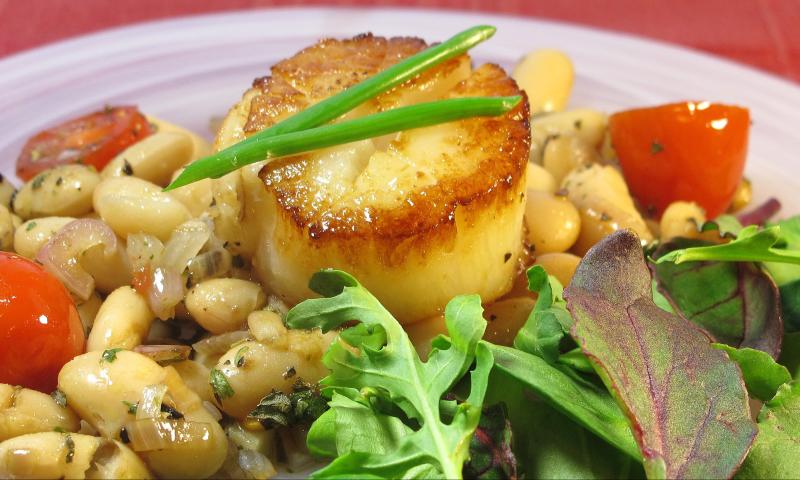Scallop dishes can be simple or special for different occasions
Today is Good Friday, a Christian holy day commemorating the crucifixion and death of Jesus Christ. Practices include worship services, vigils, almsgiving and fasting. The last of these is often observed as abstinence from meat, with an evening meal centered around a fish dish. After all the fish-on-Fridays during the weeks of Lent, the main course on this day is often something special, such as the seared scallops in the photo.
More costly than most fin fish, scallops come in a variety of forms. The most common difference is how they are handled at harvest. Wet scallops are treated with a sodium tripolyphosphate and water solution. This preserves them prior to freezing, but the treatment also makes them retain more water weight. While their looks are improved by plumpness and a sheen of white color, STP detracts from the texture and taste, leaving these scallops watery and rubbery when cooked.
Dry scallops are more costly than wet, but are well worth the extra investment. It is preferable to find these raw, but if you have to buy them frozen, be gentle when you thaw them. Allow them to thaw slowly; let them spend the night in the refrigerator and resist the temptation to run them under water, which may cause them to become waterlogged and difficult to cook correctly. Always pat dry the scallops with paper towels so they can go into the pan as dry as possible.
Before seasoning or cooking the scallops, remove the side muscle. It is easy to see at the edge of the scallop flesh; the spot will be a slightly different color and about the size of your small fingernail. Simply pinch it off and discard it. if you leave it intact, you will be leaving a tough, chewy bite that will disappoint the diner expecting tender scallop flesh.
In addition to wet and dry, there are other differentiators when looking for scallops. The most obvious contrast is between bay and sea scallops. Many believe the smaller bay scallops are sweeter and more tender; these are often seen fried or incorporated into a chowder. Sea scallops are saltier and have a thicker texture, making them ideal to become the centerpiece of a dish.
Like most seafood enjoyed by humans, scallops have been on the menu for thousands of years. Their name comes from the repeated curves along the edge of their shell, often seen in art (think of “The Birth of Venus” where the goddess stands in the center of a scallop shell). The scallop shell is a common decorative motif in classical wooden furniture pieces, either at the center of a desk skirt or carved into the knees of chair legs.
Another aspect in the symbolism of the scallop shell is its association with pilgrimage attributed to Saint James. It appears in heraldry as a badge for those who have been on a pilgrimage, especially the trek along the Camino de Santiago. It is from James that we derive the name of a favorite scallop recipe, coquilles Saint Jacques, a rich dish of scallops served in the shell topped with a creamy sauce and toasted bread crumbs.
Pan searing is my favorite way to cook scallops, because it creates a beautiful caramelized crust that adds a rich, savory and slightly nutty flavor. Searing the scallops in a pan helps them maintain their delicate texture while also cooking them quickly. You begin by finding the flatter, wider end or “face.” You want to put the face with the larger circumference on the pan bottom first to make contact with hot oil. Once in the pan, allow them to cook for about 2 minutes. Don't touch them. Don't move them. Then turn them and cook for another few minutes and serve immediately on a bed of greens or with your favorite sides.
Pan-Seared Scallops
Pat dry the scallops thoroughly. Dust the larger face with flour; sprinkle with salt and pepper. Heat oil in a large skillet over medium high. When oil is shimmering, place the scallops in the pan, seasoned side down. Cook until browned, about 2 minutes. While cooking, season the tops with a little salt and pepper. Flip the scallops and cook for another minute or two. Serve immediately with lemon wedges. Yield: 4 servings.
Coquilles St. Jacques*
Preheat broiler. Coat the inside of 4 scallop serving shells or individual gratin dishes with nonstick cooking spray; set aside. Melt butter in a saucepan over medium. Add shallots, garlic, mushrooms and salt; cook until softened, about 5 minutes. Add wine and raise heat to medium high; cook until evaporated, about 3 minutes. Reduce heat and stir in cream; simmer until thickened, about 5 minutes. Cut the scallops in half horizontally and add to the sauce. Cook until barely translucent, about 90 seconds. Remove from heat and stir in lemon juice. Ladle scallops and sauce into prepared shells; top with bread crumb mixture. Broil until golden, about 90 seconds. Yield: 4 servings. *Adapted from Joy of Cooking.


















































